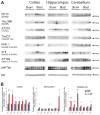Blast exposure causes early and persistent aberrant phospho- and cleaved-tau expression in a murine model of mild blast-induced traumatic brain injury
- PMID: 23948882
- PMCID: PMC4126588
- DOI: 10.3233/JAD-130182
Blast exposure causes early and persistent aberrant phospho- and cleaved-tau expression in a murine model of mild blast-induced traumatic brain injury
Abstract
Mild traumatic brain injury (mTBI) is considered the 'signature injury' of combat veterans that have served during the wars in Iraq and Afghanistan. This prevalence of mTBI is due in part to the common exposure to high explosive blasts in combat zones. In addition to the threats of blunt impact trauma caused by flying objects and the head itself being propelled against objects, the primary blast overpressure (BOP) generated by high explosives is capable of injuring the brain. Compared to other means of causing TBI, the pathophysiology of mild-to-moderate BOP is less well understood. To study the consequences of BOP exposure in mice, we employed a well-established approach using a compressed gas-driven shock tube that recapitulates battlefield-relevant open-field BOP. We found that 24 hours post-blast a single mild BOP provoked elevation of multiple phospho- and cleaved-tau species in neurons, as well as elevating manganese superoxide-dismutase (MnSOD or SOD2) levels, a cellular response to oxidative stress. In hippocampus, aberrant tau species persisted for at least 30 days post-exposure, while SOD2 levels returned to sham control levels. These findings suggest that elevated phospho- and cleaved-tau species may be among the initiating pathologic processes induced by mild blast exposure. These findings may have important implications for efforts to prevent blast-induced insults to the brain from progressing into long-term neurodegenerative disease processes.
Figures







References
-
- Hoge CW, McGurk D, Thomas JL, Cox AL, Engel CC, Castro CA. Mild traumatic brain injury in U.S. Soldiers returning from Iraq. N Engl J Med. 2008;358:453–463. - PubMed
-
- Erlanger DM, Kutner KC, Barth JT, Barnes R. Neuropsychology of sports-related head injury: Dementia pugilistica to post concussion syndrome. Clin Neuropsychol. 1999;13:193–209. - PubMed
-
- Omalu BI, DeKosky ST, Minster RL, Kamboh MI, Hamilton RL, Wecht CH. Chronic traumatic encephalopathy in a National Football League player. Neurosurgery. 2005;57 :128–134. - PubMed
Publication types
MeSH terms
Substances
Grants and funding
LinkOut - more resources
Full Text Sources
Other Literature Sources
Research Materials

